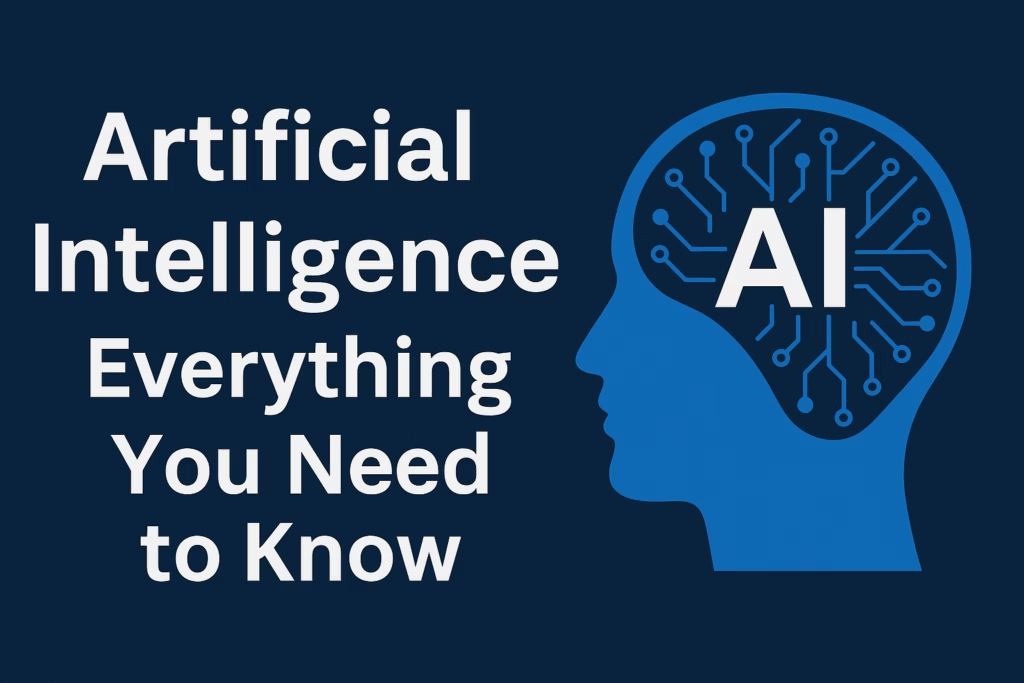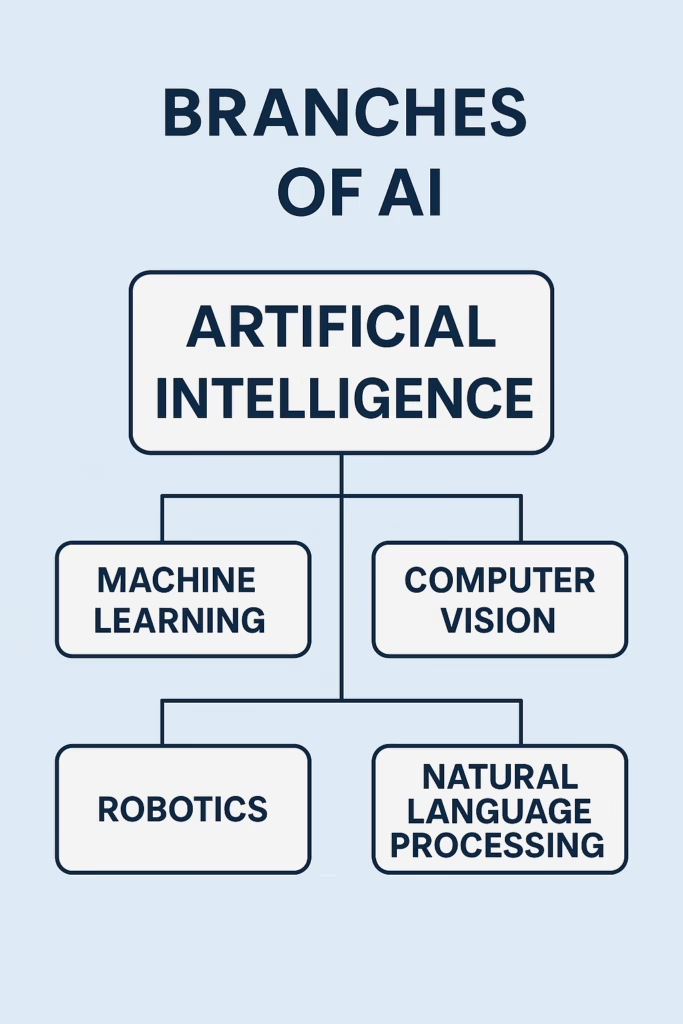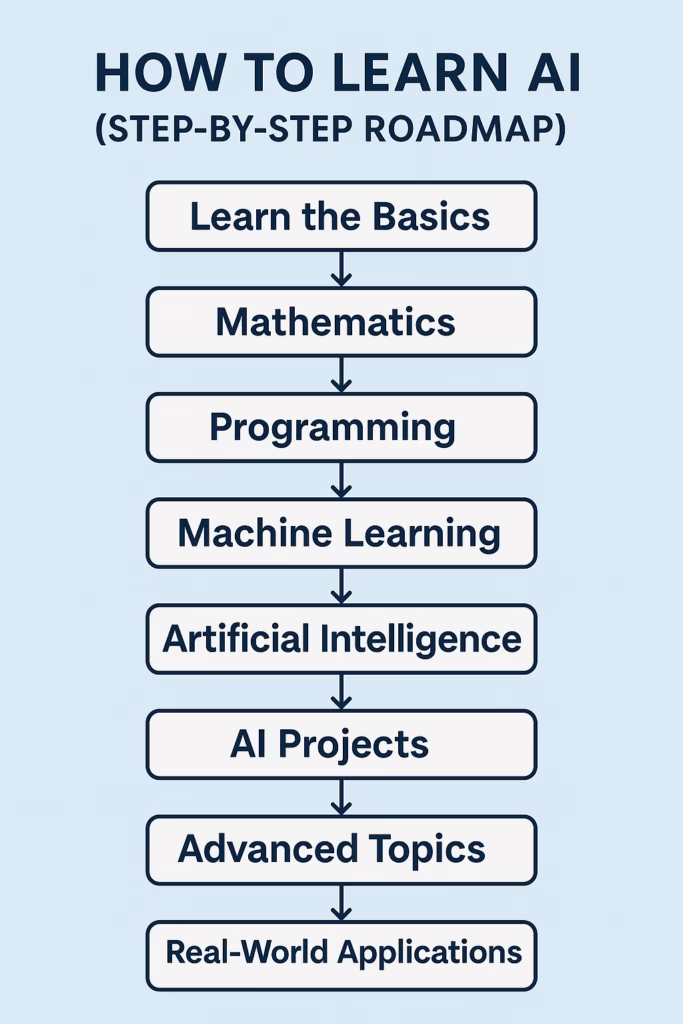Artificial Intelligence (AI) is no longer confined to science fiction- it’s a reality shaping how we live, work, and interact. From personal assistants like Siri and Alexa to complex medical diagnosis systems, AI is everywhere. But what exactly is AI? How does it work, and why does it matter?
This guide breaks down everything you need to know about Artificial Intelligence—its meaning, key features, different branches, real-world applications, benefits, challenges, future trends, and how to start learning it.

What is Artificial Intelligence?
Artificial Intelligence (AI) refers to the ability of machines to perform tasks that usually require human intelligence. These tasks include understanding language, recognizing patterns, solving problems, and making decisions.
At its core, AI is about creating machines that can think and learn—from analyzing massive amounts of data to predicting future outcomes.
📌 Simple Example:
- Netflix/YouTube recommending your video or Movie.
- Google Maps suggesting the fastest route.
- AI Chat Apps (ChatGPT) responding to your queries.
Key Features of AI
AI systems are defined by several powerful features:
- Automation – AI can automate repetitive tasks, reducing human effort.
- Learning Ability – Through machine learning, AI improves as it processes more data.
- Data-Driven Insights – AI extracts meaningful patterns from massive datasets.
- Problem-Solving – AI can make predictions and decisions to solve real-world challenges.
- Human-Like Interaction – Natural Language Processing (NLP) allows AI to communicate in human language.
Types and Branches of AI

1. Machine Learning (ML)
- Systems learn from data without being explicitly programmed.
- Used in fraud detection, recommendation systems, and predictive analytics.
2. Deep Learning
- A subset of ML inspired by the human brain (neural networks).
- Powers advanced tasks like image recognition, speech-to-text, and generative AI (ChatGPT, Replika).
3. Natural Language Processing (NLP)
- AI that understands and generates human language.
- Used in chatbots, voice assistants, and translation services.
4. Computer Vision (CV)
- Enables machines to interpret visual information from the world.
- Used in self-driving cars, facial recognition, and medical imaging.
5. Robotics
- AI combined with hardware to perform tasks in the physical world.
- Examples: autonomous drones, robotic surgery, warehouse robots.
6. Expert Systems
- Rule-based AI that uses a knowledge base for decision-making.
- Common in healthcare diagnosis and troubleshooting systems.
Applications of AI in 2025
AI impacts nearly every industry:
- Healthcare 🏥 – AI-powered diagnostics, drug discovery, robotic surgery.
- Finance 💰 – Fraud detection, trading algorithms, AI chatbots. Check out detailed guide on AI in Finance
- Education 📚 – Personalized learning, AI tutors, grading automation.
- Transportation 🚗 – Self-driving cars, route optimization, traffic prediction.
- Business & Marketing 📈 – Customer insights, recommendation engines, chatbots.
- Creative Arts 🎨 – AI-generated music, writing, design, and video creation.
👉 Check out more about Work Smarter, Live Better: Best Smart Life Apps
Benefits of Artificial Intelligence
- Increases efficiency by automating tasks.
- Provides accuracy and reduces human error.
- Delivers personalization (recommendations, targeted ads).
- Unlocks innovation across industries.
- Processes and analyzes big data faster than humans.
Challenges and Risks of AI
AI is powerful, but it comes with challenges:
- Data Privacy concerns with sensitive information.
- Bias & Fairness issues due to biased training data.
- Job Displacement from automation replacing roles.
- High Costs of building and maintaining AI systems.
- Ethical Concerns like lack of transparency (black-box AI).
Future of AI: 2025 and Beyond
The future of AI is both exciting and challenging. By 2030, AI could add trillions of dollars to the global economy. Key trends include:
- Smarter AI healthcare assistants.
- Fully autonomous transportation systems.
- AI-driven creativity (films, books, design).
- AI in every home (smart appliances, personal assistants).
- Stronger focus on Ethical AI and regulations.
How to Learn AI (Step-by-Step Roadmap)
Interested in building your career in AI? Here’s a high-level roadmap:
- Foundations: Learn Python, math (statistics, linear algebra), and data handling.
- Machine Learning: Study algorithms like regression, decision trees, clustering.
- Deep Learning: Explore neural networks, CNNs, RNNs, transformers.
- Specializations: Dive into NLP, Computer Vision, or Robotics.
- Projects: Build hands-on AI projects like chatbots, image classifiers, or recommendation engines.
- Deployment & MLOps: Learn how to take models into production using cloud platforms.
- Stay Updated: AI evolves quickly—follow research, blogs, and courses.

👉 Check out our AI Learning Roadmap 2025 for a complete step-by-step guide.
Conclusion
Artificial Intelligence is more than a technological trend—it’s the foundation of the digital future. From healthcare to entertainment and Cooking, AI is unlocking opportunities we couldn’t imagine a decade ago.
Whether you’re a beginner curious about AI or a professional aiming to grow your skills, understanding AI is essential in 2025 and beyond. Use this guide as your starting point, and explore our in-depth resources to dive deeper into Machine Learning, NLP, Computer Vision, and more.
